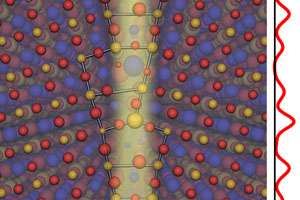The image shows atomised positions along a grain boundary. The red line to the right shows the charge density along this boundary.
An international group of physicists from the University of Augsburg in Germany, the University of Florida in Gainesville, and the Niels Bohr Institute at the University of Copenhagen have succeeded in creating a theoretical modelling of the microscopic defects in superconductors and in discovering the main cause for the drastic drop in the electric current. The results have been published in the internationally recognized scientific journal, Nature Physics.
In a time where the political and scientific discussion is focused on the global energy crisis, research is being done on alternative techniques for the production of energy and new ways of reducing energy consumption. A superconductor is based on a complex quantum state and can be used to transport energy with minimal energy loss.
Low temperature gives low resistance
The phenomenon of superconductors has been known for almost a century, but the problem up until now has been that superconductors can only function at very low temperatures - temperatures that are very difficult to achieve. The first superconductors were cooled to a few degrees above absolute zero (minus 273 degrees Celsius).
It was only 25 years ago that the use of superconductors for electricity came within reach. It was discovered then that the superconducting properties of some copper oxide compounds could be improved by cooling liquid air at very low temperatures. Today, we are up to around minus 140 degrees Celsius with copper oxide materials.
Small defects causing major damage
But you run into another obstacle in the use of superconductors - the microscopic defects that are found in almost all materials. The small defects on the boundary between the individual, grain boundaries affect the transport of electric current in the superconductor. Up until now no one has succeeded in developing a theoretical understanding of this phenomenon even though the effect is well known from experiments and even though there are also various methods for improving the physical properties of the materials.
Theoretical understanding
"We have now made a theoretical modelling of the microscopic defects in these materials and simulated a superconducting current. We have managed to identify an accumulated electrical charge on the boundary between different misoriented crystal axes, as the main cause of the drastic drop in the electric current", explains physicist Brian M. Andersen, Niels Bohr Institute at the University of Copenhagen.
The theoretical understanding of high temperature superconductors can now be used for further research into methods that can improve the transport of energy in copper oxide materials, research that ultimately could lead to the use of high energy superconductors for supplying electricity.
More information: Read the publication in Nature Physics.
Provided by Niels Bohr Institute





















